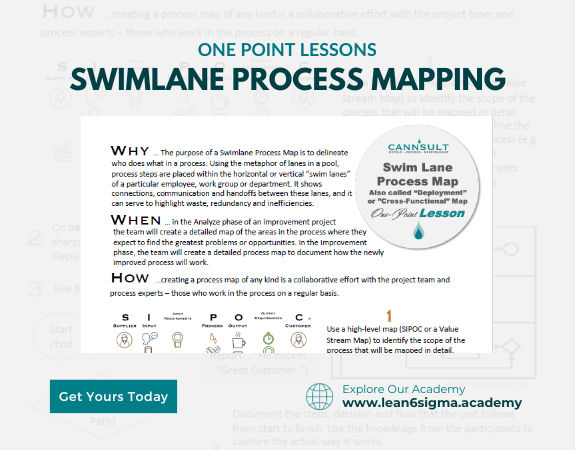Swimlane Process Mapping
Hand-offs identified
Quick reference
Stay in your Lane!
Streamline your processes
Hold people accountable
Problem solving
Swimlane Process Mapping is a visual tool used to depict complex processes by assigning specific responsibilities or departments to individual lanes, providing clarity and improving collaboration.
Description:
Swimlane Process Mapping is a technique for creating visual representations of processes, particularly those involving multiple stakeholders, teams, or departments. It clarifies who is responsible for each step and enhances understanding and collaboration.
Steps:
Select the Process: Choose the specific process you want to map. Ensure that the process involves multiple stakeholders or departments.
Identify Swimlanes: Define the Swimlanes or columns on the process map. Each Swimlane represents a specific entity, department, team, or stakeholder involved in the process.
Document the Process: Sequentially document each step or activity within the process.
Place each step within the appropriate swimlane, indicating which entity or department is responsible for that step.
Capture Inputs and Outputs: Record what inputs or information are required to initiate each step.
Document the expected outputs or results from each step within the respective swimlanes.
Use Standard Symbols: Employ standardized process mapping symbols to represent activities, decisions, data flows, and more within the swimlanes. This ensures consistency and understanding.
Include Decision Points: Clearly mark decision points within the process map and assign them to the relevant swimlanes, indicating which entity or department is responsible for making the decision.
Gather Data: Collect data on process performance metrics, such as cycle times, handover delays, or error rates, as needed.
Analyze and Optimize: Review the swimlane process map to identify bottlenecks, handover issues, or areas for improvement. Collaborate with the respective entities or departments to gather insights.
Implement Improvements: Based on your analysis, implement changes to the process that enhance efficiency and collaboration. Monitor and measure the impact of these improvements.
Benefits:
Enhanced process visibility
Clarity of responsibilities
Improved collaboration and handovers
Identification of areas for streamlining
Key Takeaway:
Swimlane Process Mapping is a powerful visual tool for understanding and improving processes involving multiple stakeholders or departments. It provides clarity about responsibilities and handovers, promoting collaboration and efficiency.

0 Reviews
Riaan is a dynamic leader, coach, facilitator, Lean Six Sigma Master Black Belt with over 20 years of hands-on experience driving business results. Riaan is highly skilled and has worked across diverse industries internationally. With a degree in Chemical Engineering, Riaan started in the major breweries and bakeries in South Africa and was so dedicated to his work that he was often known to take his work home with him.
